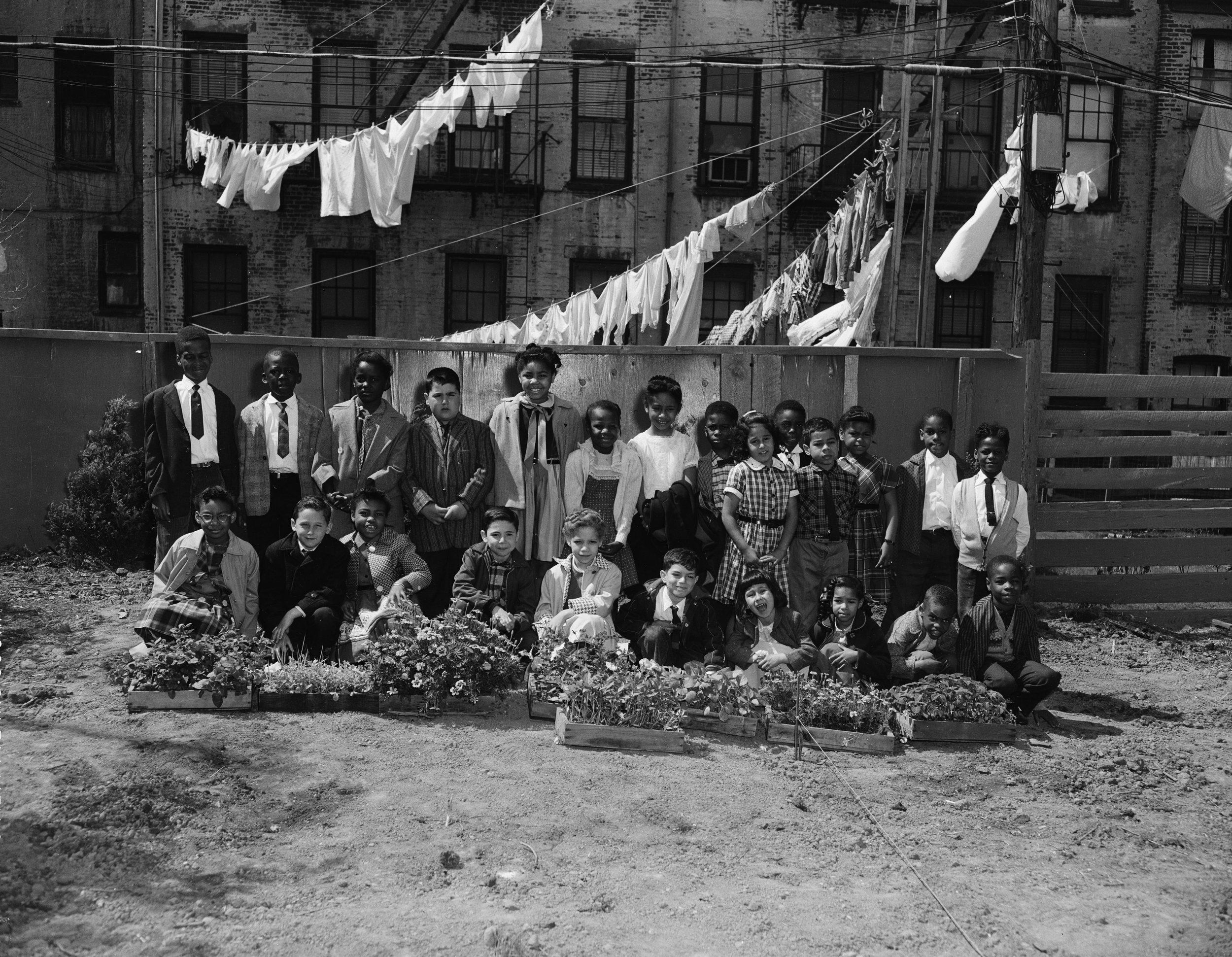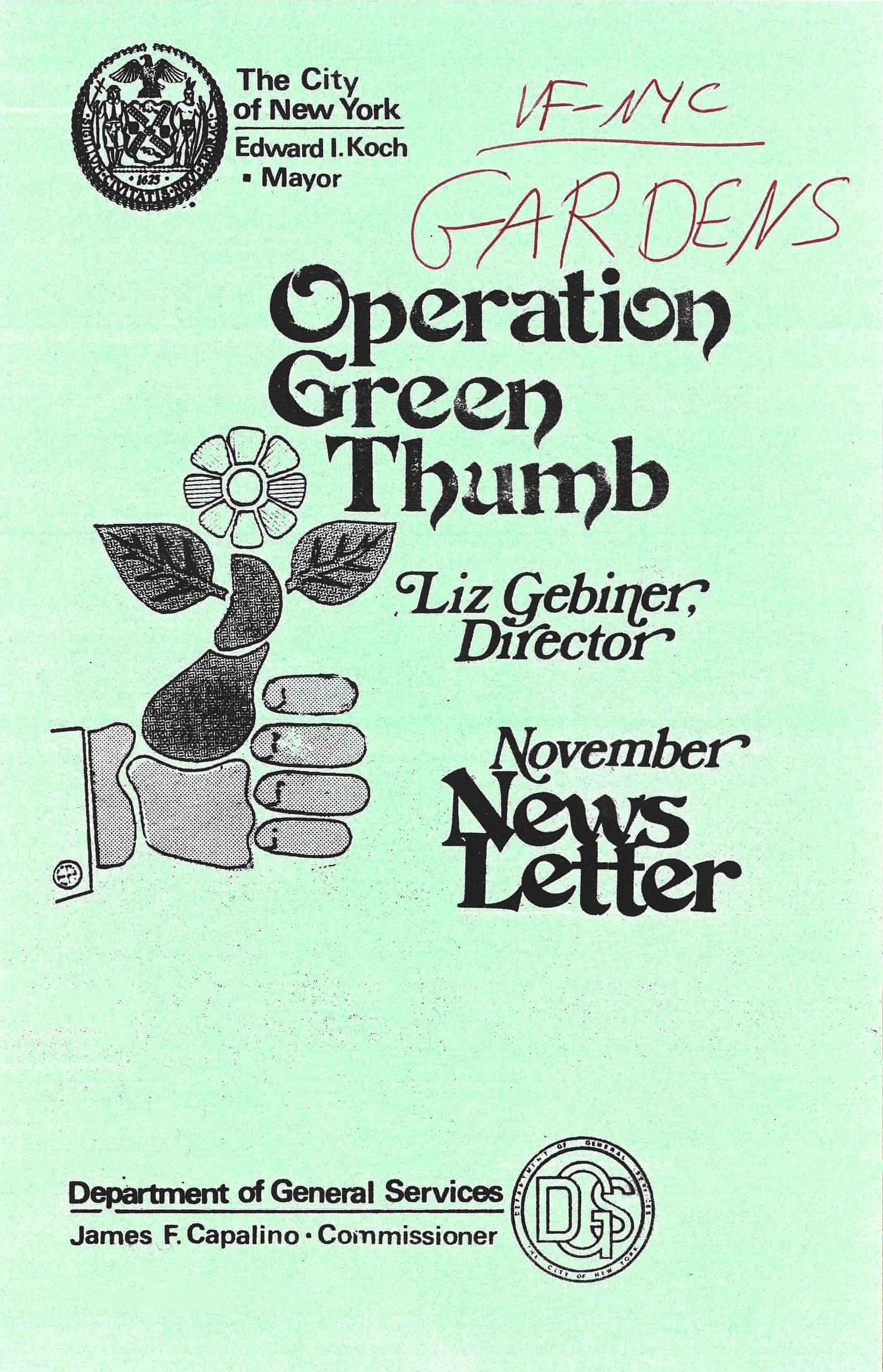At summer’s end, New Yorkers lucky enough to have a plot in a community garden are enjoying the fruits (and vegetables) of their labor. This week, For the Record examines the Municipal Library’s vertical files to tell the story of community gardens. And it’s a classic New York tale, with neighborhood characters, celebrities, villains and heroes.
Historians trace the first community garden back to the city’s Almshouse in the 1730s. The “inmates” (as they were called) worked in communal gardens, both for therapeutic reasons and to offset the cost of their maintenance in the institution. Nineteenth and early twentieth-century gardens were generally informal arrangements. For the Record’s article on Victory Gardens described the World War II-era plots that sprang-up around the city.
The Municipal Library’s articles, brochures, press releases and ephemera in the vertical file on “NYC Gardens” picks up the story in the 1960s and 70s when arson and disinvestment in housing stock led to the proliferation of vacant lots. The lots attracted rats, became dumping grounds for garbage and venues for illegal activities. As a way of improving their blighted neighborhoods, community groups began advocating for permission to build gardens in the lots.
Miracle Garden Bond & Wyckoff Streets, May 3, 1960. Department of Sanitation collection, NYC Municipal Archives.
Clipped articles in the file with headlines such as “1,000 ‘Farms’ Planned on Lots in New York,” describe these efforts: “Garbage-littered lots, many of them in the most rundown sections of New York City, will become vegetable gardens under a program to green the city by creating a thousand farms in low-income neighborhoods.” The story goes on to describe a Cornell University-sponsored program that supplied expertise, soil, tools and fertilizer to neighborhood groups.(New York Times, April 26, 1977.)
Operation Green Thumb, November 1979. NYC Municipal Library Vertical File, NYC Gardens.
Community gardens gained momentum in 1978 with establishment of Operation GreenThumb, a community gardening program originally sponsored by the City’s Department of General Services, (and celebrating its 45th anniversary this year). According to an undated “Fact Sheet” in the vertical file, GreenThumb leased vacant property to non-profit organizations which established community vegetable and flower gardens. GreenThumb’s staff provided training and issued tools, soil, seeds and bulbs. By the 1990s, according to the Fact Sheet, GreenThumb leased more than 1,000 lots comprising 125 acres to 700 community groups and planted 2,000 apple, peach, plum and cherry trees.
Another item in the file, a clipping from the “Daily Planet,” (Department of Parks and Recreation Newsletter), dated September 10, 1986, describes a community garden dedication ceremony: “Yesterday, at the end of a beautiful, late summer day, a hundred friends of green spaces in the city gathered to dedicate the Liz Christy Bowery Houston Garden on the Lower East Side. The ceremony, hosted by the Green Guerillas and the Council on the Environment of New York City, who jointly operate the garden, honored the memory of the woman who was the founder of New York’s open space greening movement.”
The rosy picture painted in the Daily Planet and the impressive facts and figures in the Fact Sheet failed to acknowledge the clouds gathering over the City’s sunny gardens that began to develop during the 1980s and 90s. With the city recovering from the fiscal crisis of the 1970s, the demand for low-income housing began to ramp-up. Clipped articles in the files with headlines such as “Gardens face uprooting” are typical: “Community gardeners in Manhattan and the Bronx are fighting to keep their land. They are trying to keep their gardens alive after years of pruning, planting, and cultivating, despite a city plan to demolish hundreds of them to build new housing or businesses.” (New York Daily News, November 2, 1997.)
N.Y. Water Saver’s Guide to Gardening. Mayor’s Commission on Water Conservation, 1988. NYC Municipal Library Vertical File, NYC Gardens.
Thanks to the diligent librarians, the vertical file includes several news clippings from the 1980s that tell the saga of Adam Purple and his Garden of Eden. In 1982, the Daily News described Mr. Purple as a “... middle-aged, bearded modern-day flower child,” (February 25, 1982). Other stories added that he typically wore a “purplish, pajama-like suit and purple hair.” The city decided it wanted Purple’s garden to build 189 units of low-income housing on the garden he had nurtured for thirteen years. The dispute wound up in court. In 1985 a federal judge ruled against Purple, and his garden was bulldozed.
During the Rudolf Giuliani administration (1994-2001), with the city even more desperate for housing, fights about the gardens escalated. “Herbicidal Maniac Loose in City! Guiliani Moves to Uproot Gardens,” read a headline in the May 1998 Metropolitan Council on Housing newsletter. “Folks Seeing Red Over Losing Green,” was the banner headline in Newsday: “...the city wants to auction 75 of these community-tended vegetable and flower gardens to the highest bidders. It’s the city’s version of a garage sale, and Mayor Rudy Giuliani has little sympathy for the people who have transformed junkyard lots and eyesores into gardens and community meeting places.” (Newsday, January 19, 1999)
Green Guerillas, Winter 1999. NYC Municipal Library Vertical File, NYC Gardens.
But salvation came at the last minute, literally one day before the auction. “Sudden Deal Saves Gardens Set for Auction,” read the New York Times article on May 13, 1999. “A day before the Giuliani administration was to auction off city-owned lots that had been transformed into community gardens, the performer Bette Midler had her private conservation organization [The New York Restoration Project] agree to buy dozens of the less desirable parcels, providing the final funding to preserve all 112 gardens that were set for sale.”
The last folder in the community garden vertical file contains articles from the early 2000s. During the Michael Bloomberg administration (2002-2013), the city adopted a more conciliatory posture with regard to the gardens, working toward balancing the need for additional housing against the popular green spaces. In 2002, the Times reported that “... the Bloomberg administration and Mr. Spitzer [New York State Attorney General] have begun negotiations that both sides hope will result in some gardens reverting to the city for development of low-income housing, and some going to community. Mr. Bloomberg has said recently that he believes that community gardens are viable in some situations, but that housing is preferable in others.” (New York Times, April 26, 2002.)
GreenThumb Fall 2023 Program Guide, NYC Parks Department.
With the advent of digitized media, the librarians mostly discontinued adding to the vertical files after the early 2000s. Although the contents of the community garden vertical file ends in early 2002, the Municipal Library’s publications portal picks up the story. One of the more recent documents is a press release, dated September 25, 2013, jointly issued by the Department of Environmental Protection, and the New York Restoration Project (NYRP). The release announced that the NYRP had “. . . recently completed the renovation of its Gil Hodges Community Garden in Brooklyn’s Gowanus Canal neighborhood. . . . with high-performance storm water infrastructure.”
For the Record articles have frequently highlighted the vertical files. The cabinets contain articles clipped by the librarians from newspapers and magazines, as well as other printed items such as pamphlets, brochures and press releases on topics relevant to New York City government and history. They are arranged by subject and generally date from the 1920s with the bulk gathered between 1950 and the early 2000s
Although eclectic, they are a very valuable resource; much of the content is not available anywhere else; has not been digitized, and is unlikely to be.
Researchers in the Municipal Library and Archives can ask the reference staff for the list of extant vertical files and in most instances, the requested materials can be produced right away.




